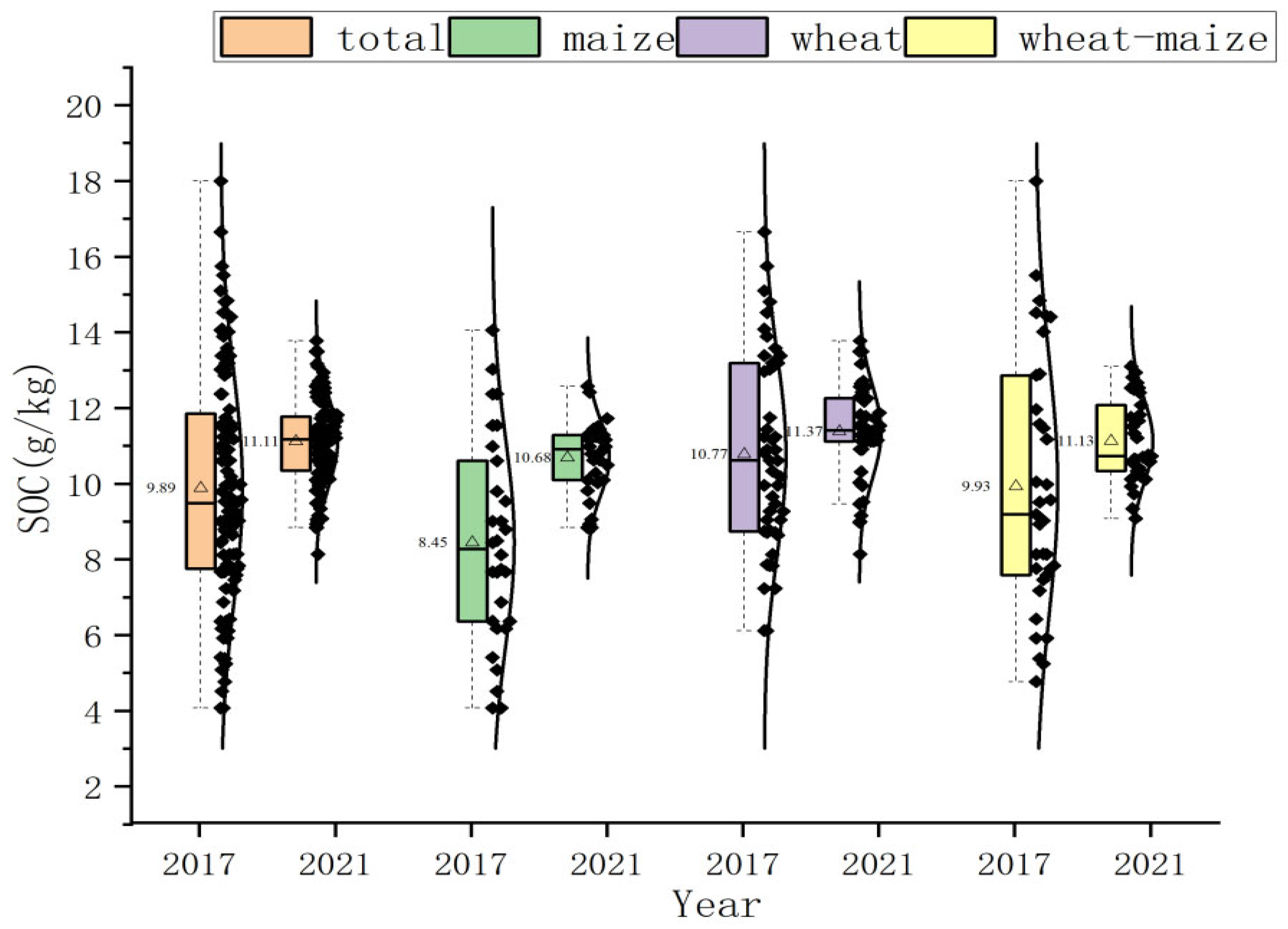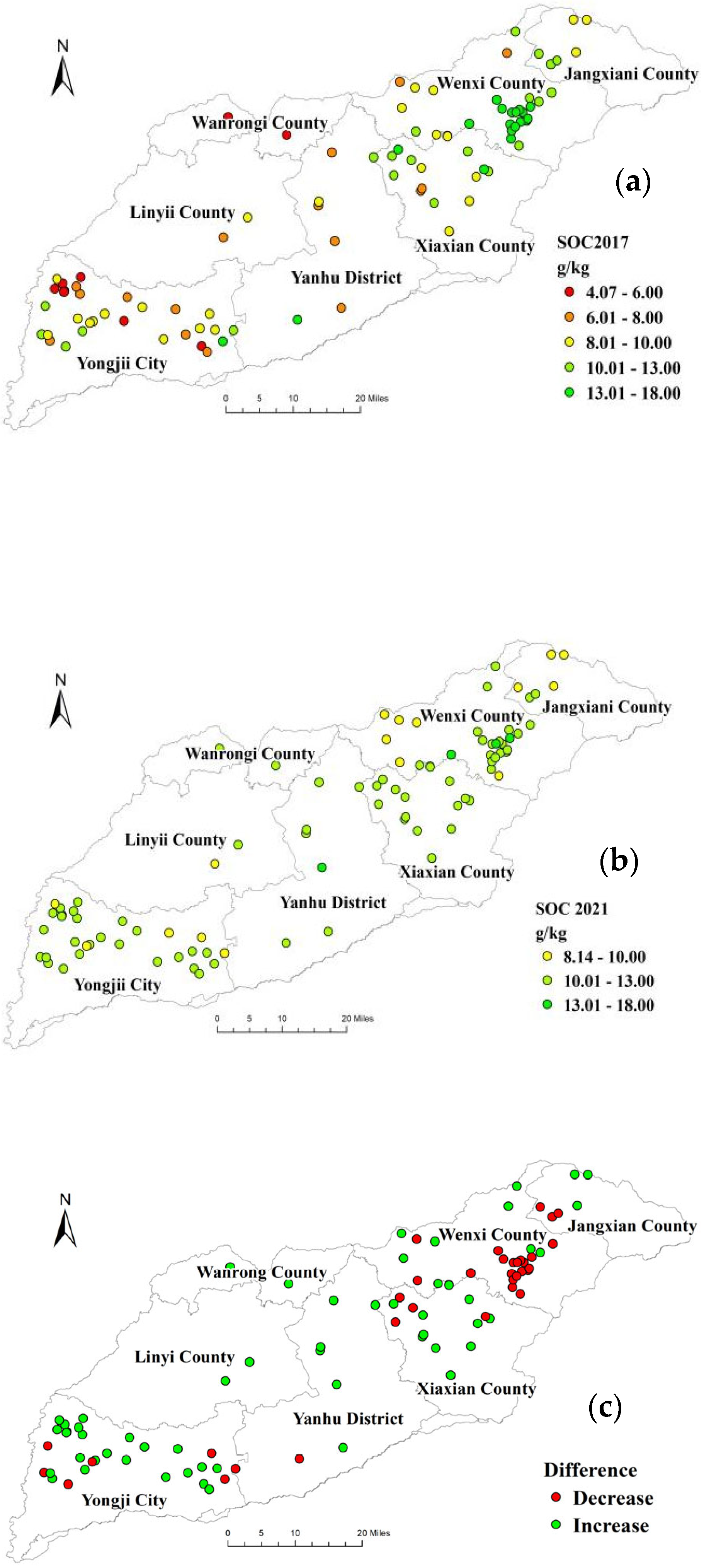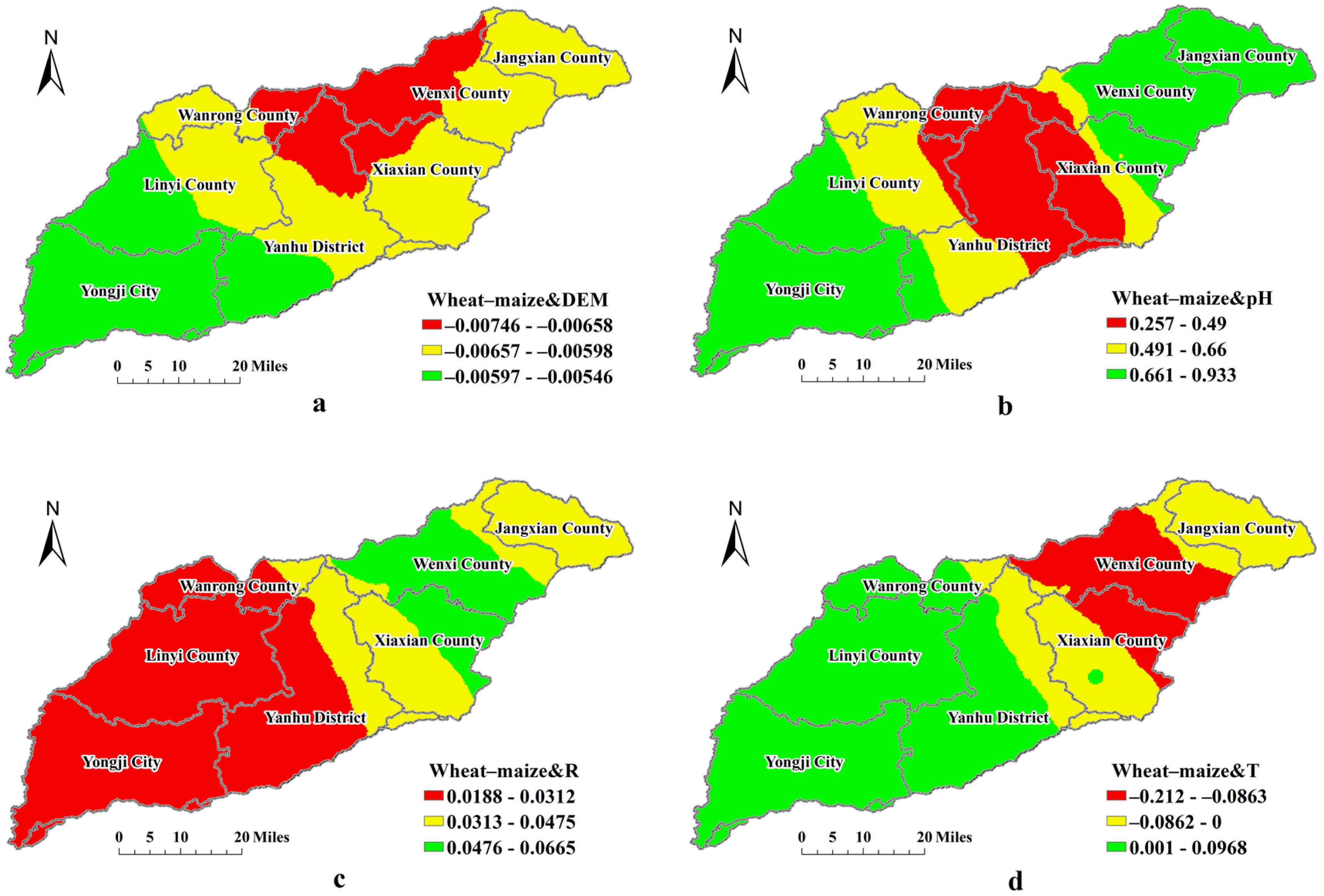Whether Wheat–Maize Rotation Influenced Soil Organic Carbon Content in Sushui River Basin
Abstract
1. Introduction
2. Materials and Methods
2.1. Study Area Overview
2.2. Soil Data and Influential Factors
2.3. Analysis Methods
2.3.1. Analysis of Variance (ANOVA)
2.3.2. Geodetector
2.3.3. GWR Model
3. Results
3.1. Analysis of Spatial and Temporal Variation Patterns in SOC Content
3.1.1. Changes in Basic Statistical Indicators
3.1.2. Changes in Spatial Distribution of SOC
3.2. Geodetector-Based Spatial Heterogeneity Factor Analysis of SOC
3.3. GWR-Based Analysis of the Effect of Wheat–Maize Crop Rotation on SOC
4. Discussion
4.1. Effect of Cropping System on SOC
4.2. Spatial Heterogeneity of the Effect of Wheat and Maize Crop Rotation Cultivation on SOC
4.3. Shortcomings and Directions for Improvement
5. Conclusions
Author Contributions
Funding
Data Availability Statement
Acknowledgments
Conflicts of Interest
References
- Pan, G.; Ding, Y.; Chen, S. Exploring the nature of soil organic matter from humic substances isolation to SOMics of molecular assemblage. Adv. Earth Sci. 2019, 34, 451–470. [Google Scholar]
- Xiao, G.; Hu, Y.; Zhang, Q.; Wang, J.; Li, M. Impact of cultivation on soil organic carbon and carbon sequestration potential in semiarid regions of China. Soil Use Manag. 2020, 36, 83–92. [Google Scholar] [CrossRef]
- Wu, Z.; Liu, Y.; Han, Y.; Zhou, J.; Liu, J.; Wu, J. Mapping farmland soil organic carbon density in plains with combined cropping system extracted from NDVI time-series data. Sci. Total Environ. 2021, 754, 142120. [Google Scholar] [CrossRef] [PubMed]
- Lal, R. Managing world soils for food security and environmental quality. Adv. Agron. 2001, 74, 155–192. [Google Scholar] [CrossRef]
- Lal, R. Soil carbon-sequestration impacts on global climate change and food security. Science 2004, 304, 1623–1627. [Google Scholar] [CrossRef] [PubMed]
- Dong, Q.; Chen, X.; Chen, J.; Zhang, C.; Liu, L.; Cao, X.; Zang, Y.; Zhu, X.; Cui, X. Mapping winter wheat in North China using Sentinel 2A/B data: A method based on phenology-time weighted dynamic time warping. Remote Sens. 2020, 12, 1274. [Google Scholar] [CrossRef]
- Lamichhane, S.; Kumar, L.; Wilson, B. Digital soil mapping algorithms and covariates for soil organic carbon mapping and their implications: A review. Geoderma 2019, 352, 395–413. [Google Scholar] [CrossRef]
- Tian, H.; Zhang, J.; Zheng, Y.; Shi, J.; Qin, J.; Ren, X.; Bi, R. Prediction of soil organic carbon in mining areas. CATENA 2022, 215, 106311. [Google Scholar] [CrossRef]
- Saikat, C.; Nanthi, B.; Mark, F.; Binoy, S.; Jharna, R.; Mary, B.; Hossain, M.; Kim, G. Role of cultural and nutrient management practices in carbon sequestration in agricultural soil. Adv. Agron. 2020, 166, 131–193. [Google Scholar]
- Yang, Y.; Ti, J.; Zou, J.; Wu, Y.; Rees, R.M.; Harrison, M.T.; Li, W.; Huang, W.; Hu, S.; Liu, K.; et al. Optimizing crop rotation increases soil carbon and reduces GHG emissions without sacrificing yields. Agric. Ecosyst. Environ. 2023, 342, 108220. [Google Scholar] [CrossRef]
- Yang, L.; Song, M.; Zhu, A.X.; Qin, C.; Zhou, C.; Qi, F.; Li, X.; Chen, Z.; Gao, B. Predicting soil organic carbon content in croplands using crop rotation and Fourier transform decomposed variables. Geoderma 2019, 340, 289–302. [Google Scholar] [CrossRef]
- Zheng, F.; Liu, X.; Ding, W.; Song, X.; Li, S.; Wu, X. Positive effects of crop rotation on soil aggregation and associated organic carbon are mainly controlled by climate and initial soil carbon content: A meta-analysis. Agric. Ecosyst. Environ. 2023, 355, 108600. [Google Scholar] [CrossRef]
- Schmer, M.R.; Jin, V.L.; Wienhold, B.J.; Becker, S.M.; Varvel, G.E. Long-term rotation diversity and nitrogen effects on soil organic carbon and nitrogen stocks. Agrosystems Geosci. Environ. 2020, 3, e20055. [Google Scholar] [CrossRef]
- Lobe, I.; Sandhage-Hofmann, A.; Brodowski, S.; Du Preez, C.C.; Amelung, W. Aggregate dynamics and associated soil organic matter contents as influenced by prolonged arable cropping in the South African Highveld. Geoderma 2011, 162, 251–259. [Google Scholar] [CrossRef]
- Ma, P.; Nan, S.; Yang, X.; Qin, Y.; Ma, T.; Li, X.; Yu, Y.; Bodner, G. Macroaggregation is promoted more effectively by organic than inorganic fertilizers in farmland ecosystems of China—A meta-analysis. Soil Tillage Res. 2022, 221, 105394. [Google Scholar] [CrossRef]
- Bansal, S.; Yin, X.; Sykes, V.; Lee, J.; Jagadamma, S. Soil aggregate-associated organic carbon and nitrogen response to long-term no-till crop rotation, cover crop, and manure application. Soil Sci. Soc. Am. J. 2021, 85, 2169–2184. [Google Scholar] [CrossRef]
- Nandan, R.; Singh, V.; Singh, S.S.; Kumar, V.; Hazra, K.K.; Nath, C.P.; Poonia, S.; Malik, R.K.; Bhattacharyya, R.; McDonald, A. Impact of conservation tillage in rice–based cropping systems on soil aggregation, carbon pools and nutrients. Geoderma 2019, 340, 104–114. [Google Scholar] [CrossRef] [PubMed]
- Lal, R. Soil organic matter content and crop yield. J. Soil Water Conserv. 2020, 75, 27A–32A. [Google Scholar] [CrossRef]
- Montgomery, D.R. Farming Revolution: Let the Soil Change Machine; Ganlin, M.Z., Translator; Shanghai Science and Technology Press: Shanghai, China, 2019. [Google Scholar]
- Deiss, L.; Sall, A.; Demyan, M.S.; Culman, S.W. Does crop rotation affect soil organic matter stratification in tillage systems. Soil Tillage Res. 2021, 209, 104932. [Google Scholar] [CrossRef]
- Luo, Z.; Wang, E.; Sun, O.J. Soil carbon change and its responses to agricultural practices in Australian agro-ecosystems: A review and synthesis. Geoderma 2010, 155, 211–223. [Google Scholar] [CrossRef]
- Zhao, S.; Liu, B.; Lu, L.; Li, D.; Zhang, G. Spatial modeling of soil organic matter over low relief areas based on geographically weighted regression. Trans. Chin. Soc. Agric. Eng. 2019, 35, 9. [Google Scholar]
- Lal, R. Soil health and carbon management. Food Energy Secur. 2016, 5, 212–222. [Google Scholar] [CrossRef]
- Seben Junior, G.F.; Corá, J.E.; Lal, R. Soil aggregation according to the dynamics of carbon and nitrogen in soil under different cropping systems. Pesq. Agropec. Bras. 2016, 51, 1652–1659. [Google Scholar] [CrossRef][Green Version]
- Fan, L.; Zhang, D. Research on influence mechanism and spatial heterogeneity characteristics of block vitality in Beijing: Based on multi-scale geographically weighted regression. City Plan. Rev. 2022, 46, 11. [Google Scholar]
- Chen, Y.; Li, J.F.; Xu, J. The impact of socio-economic factors on ecological service value in Hubei Province: A geographically weighted regression approach. China Land Sci. 2015, 29, 89–96. [Google Scholar]
- Hu, H.; Hong, Z. Analyzing spatial effects of influencing factors on air quality in the Yellow River Basin using multi-scale geographically weighted regression. J. Appl. Stat. Manag. 2023, 42, 416–426. [Google Scholar]
- Liu, C.; Wu, X.; Wang, L. Analysis on land ecological security change and affect factors using RS and GWR in the Danjiangkou reservoir area, China. Appl. Geogr. 2019, 105, 1–14. [Google Scholar] [CrossRef]
- Vincent, D.P.O.; Lal, R. Using meta-analyses to assess pedo-variability under different land uses and soil management in central Ohio, USA. Geoderma 2014, 232–234, 56–68. [Google Scholar]
- Wang, J.; Xu, C. Geodetector: Principle and prospective. Acta Geogr. Sin. 2017, 72, 19. [Google Scholar]
- Binbin, L.; Martin, C.; Paul, H.; Fotheringham, A. Geographically weighted regression with a non-euclidean distance metric: A case study using hedonic house price data. Int. J. Geogr. Inf. Sci. 2014, 28, 660–681. [Google Scholar] [CrossRef]
- Wu, D. Spatially and temporally varying relationships between ecological footprint and influencing factors in China’s provinces using Geographically Weighted Regression (GWR). J. Clean. Prod. 2020, 261, 121089. [Google Scholar] [CrossRef]
- Zhao, H.; Shar, A.G.; Li, S.; Chen, Y.; Shi, J.; Zhang, X.; Tian, X. Effect of straw return mode on soil aggregation and aggregate carbon content in an annual maize-wheat double cropping system. Soil Till. Res. 2018, 175, 178–186. [Google Scholar] [CrossRef]
- Zhang, C.; Tang, Y.; Xu, X.; Kiely, G. Towards spatial geochemical modelling: Use of geographically weighted regression for mapping soil organic carbon contents in Ireland. Appl. Geochem. 2011, 26, 1239–1248. [Google Scholar] [CrossRef]
- Wang, J.; Wang, X.; Xu, M.; Feng, G.; Zhang, W.; Yang, X.; Huang, S. Contributions of wheat and maize residues to soil organic carbon under long-term rotation in north China. Sci. Rep. 2015, 5, 11409. [Google Scholar] [CrossRef] [PubMed]
- Zhang, C.; He, H. The evolution of spatiotemporal patterns and the influencing factors of the multiple cropping index of cultivated land in Southwest China. Agric. Res. Arid Areas 2020, 38, 222–230. [Google Scholar]
- Wynn, J.G.; Bird, M.I.; Vellen, L.; Grand-Clement, E.; Carter, J.; Berry, S.L. Continental-scale measurement of the soil organic carbon pool with climatic, edaphic, and biotic controls. Glob. Biogeochem. Cycles 2006, 20, GB1007. [Google Scholar] [CrossRef]
- Liu, W.X.; Wei, Y.X.; Li, R.C.; Chen, Z.; Wang, H.D.; Virk, A.L.; Lal, R.; Zhao, X.; Zhang, H.L. Improving soil aggregates stability and soil organic carbon sequestration by no-till and legume-based crop rotations in the North China Plain. Sci. Total Environ. 2022, 847, 157518. [Google Scholar] [CrossRef]
- Liao, Y.; Cui, J.; Yang, Z. Temperature sensitivity of soil respiration from the typical land-use types in the Sanjiang Plain, northeastern Heilongjiang Province. Geol. Bull. China 2012, 31, 164–171. [Google Scholar]
- Bi, R.; Du, J.; Chai, Y. A study on soil diversity in Sushui River based on the DEM. Chin. J. Soil Sci. 2013, 44, 266–270. [Google Scholar]
- da Silva, P.C.G.; Tiritan, C.S.; Echer, F.R.; dos Cordeiro, C.F.S.; Rebonatti, M.D.; de Santos, C.H. No-tillage and crop rotation increase crop yields and nitrogen stocks in sandy soils under agroclimatic risk. Food Crop. Resour. 2020, 258, 107947. [Google Scholar] [CrossRef]
- Zhao, Y.; Wang, B.; Liu, Q.; Song, T.; Zhang, X.; Chen, Y.; Sui, P. Characteristics of farmland water consumption under two-year wheat-maize interannual rotation patterns in Heilonggang Plain. Acta Agron. Sin. 2022, 48, 1787–1799. [Google Scholar]
- Shaheen, M.E.; Tawfik, W.; Mankola, A.F.; Gagnon, J.E.; Fryer, B.J.; El-Mekawy, F.M. Assessment of contamination levels of heavy metals in the agricultural soils using ICP-OES. Soil Sediment Contam. Int. J. 2022, 32, 665–691. [Google Scholar] [CrossRef]
- Fayek, N.; Tawfik, W.; Khalafallah, A.; Hamed, S.; Mousa, W.; Fikry, M. Evaluation of Heavy Metal Presence in Agricultural Samples of Lactuca sativa and Trifolium alexandrinum Using Picosecond Laser-Induced Breakdown Spectroscopy and Flame Atomic Absorption Spectroscopy in Banha and Giza Governorates, Egypt. Minerals 2023, 13, 1300. [Google Scholar] [CrossRef]
- Mankoula, A.F.; Tawfik, W.; Gagnon, J.; Fryer, B.; El-Mekawy, F.; Shaheen, M. Assessment of heavy metals content in the agricultural soils of kafr el-zayat egypt using laser ablation inductively coupled plasma mass spectrometry and inductively coupled plasma optical emission spectroscopy. Egypt. J. Chem. 2021, 64, 1167–1177. [Google Scholar] [CrossRef]





| Data | Source | GWR Data Processing | Geodetector Data Processing |
|---|---|---|---|
| Soil organic C content | Arable land quality monitoring data from Yuncheng City in 2017 and 2021 | Normalized values using Z-Score where is the standard deviation of the sample data. | Stratification of data using quantile method |
| pH | |||
| Soil bulk density | |||
| Elevation | 30 m SRTMDEM data from the Geospatial Data Cloud website of the Computer Network Information Center of the Chinese Academy of Sciences (www.gscloud.cn, accessed on 10 September 2020) | ||
| Slope | - | ||
| Slope direction | - | ||
| Average annual rainfall | Regional station data from the Yuncheng Meteorological Bureau for the years 2017–2021. After calculating the annual average values, kriging interpolation was used to obtain the spatial distribution data of the study area | Normalized values using Z-Score where is the standard deviation of the sample data | |
| Average annual temperature | |||
| Soil type | Harmonized World Soil Database (HWSD) | - | Calcaric Cambisols, Calcaric Fluvisols, Gleyic Luvisols, Rendzic Leptosols, Salic Fluvisols, and Calcic Luvisols |
| Land Type | Arable land quality monitoring data from Yuncheng City in 2017 and 2021. | - | Dry land and watered land |
| Food growing system | MODIS and Sentinel-2 spatial extraction | The values of 1, 2, and 3 were assigned to the maize, wheat, and wheat–maize rotations based on the duration of crop coverage of the soil in a year under monoculture, wheat, and rotation conditions | Maize monoculture, wheat monoculture, and wheat–maize crop rotation |
| Crop Growing System | Food Crop Planting System | Maximum Value (g/kg) | Minimum Value (g/kg) | Coefficient of Variation | |||
|---|---|---|---|---|---|---|---|
| 2017 | 2021 | 2017 | 2021 | 2017 | 2021 | ||
| Monocrop | Maize | 14.06 | 12.58 | 4.07 | 8.84 | 31.71% | 9.17% |
| Wheat | 16.65 | 13.78 | 6.12 | 8.14 | 23.86% | 10.73% | |
| Crop rotation | Wheat–maize | 17.99 | 13.10 | 4.77 | 9.08 | 33.43% | 9.79% |
| x1 | x6 | x7 | x8 | x10 | |
|---|---|---|---|---|---|
| q statistic | 0.05 | 0.17 | 0.12 | 0.16 | 0.19 |
| p-value | 0.05 | 0.000 | 0.03 | 0.000 | 0.01 |
| GWR Factor | OLS Coefficient | |||||||
|---|---|---|---|---|---|---|---|---|
| Average Value | Standard Deviation | Minimum Value | Median | Maximum Value | Positive Values | Negative Values | ||
| x11 | −0.006 | 0.00 | −0.007 | −0.006 | −0.005 | 0 | 112 | −0.01 |
| x12 | 0.64 | 0.17 | 0.26 | 0.72 | 0.93 | 112 | 0 | 0.75 |
| x13 | 0.04 | 0.01 | 0.02 | 0.04 | 0.07 | 112 | 0 | 0.02 |
| x14 | −0.01 | 0.09 | −0.21 | −0.03 | 0.09 | 52 | 60 | 0.07 |
| Diagnostic Information | GWR | R2 = 40.28% | AICc: 541.19 | CV = 7.37 | ||||
| OLS | R2 = 31.96% | AICc: 547.852 | CV = 7.79 | |||||
Disclaimer/Publisher’s Note: The statements, opinions and data contained in all publications are solely those of the individual author(s) and contributor(s) and not of MDPI and/or the editor(s). MDPI and/or the editor(s) disclaim responsibility for any injury to people or property resulting from any ideas, methods, instructions or products referred to in the content. |
© 2024 by the authors. Licensee MDPI, Basel, Switzerland. This article is an open access article distributed under the terms and conditions of the Creative Commons Attribution (CC BY) license (https://creativecommons.org/licenses/by/4.0/).
Share and Cite
Jing, Y.; Bi, R.; Sun, W.; Zhu, H.; Ding, H.; Jin, H. Whether Wheat–Maize Rotation Influenced Soil Organic Carbon Content in Sushui River Basin. Land 2024, 13, 859. https://doi.org/10.3390/land13060859
Jing Y, Bi R, Sun W, Zhu H, Ding H, Jin H. Whether Wheat–Maize Rotation Influenced Soil Organic Carbon Content in Sushui River Basin. Land. 2024; 13(6):859. https://doi.org/10.3390/land13060859
Chicago/Turabian StyleJing, Yingqiang, Rutian Bi, Weifeng Sun, Hongfen Zhu, Haoxi Ding, and Haixia Jin. 2024. "Whether Wheat–Maize Rotation Influenced Soil Organic Carbon Content in Sushui River Basin" Land 13, no. 6: 859. https://doi.org/10.3390/land13060859
APA StyleJing, Y., Bi, R., Sun, W., Zhu, H., Ding, H., & Jin, H. (2024). Whether Wheat–Maize Rotation Influenced Soil Organic Carbon Content in Sushui River Basin. Land, 13(6), 859. https://doi.org/10.3390/land13060859






